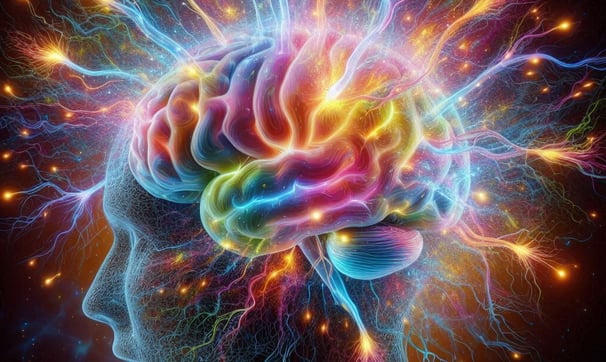read-grow.com
What is Bipolar Disorder ?
Abhishek
10/4/20243 min read


Seek the wisdom of a wise hand,
Medications taken as planned,
Move and breathe, let muscles land,
In peace of mind and body’s band .
Bipolar disorders are mental health conditions characterized by periodic, intense emotional states affecting a person's mood, energy, and ability to function. These periods, lasting from days to weeks, are called mood episodes.
Mood episodes are categorized as -
-Manic/hypomanic episodes-When the predominant mood is intensely happy or irritable.
-Depressive episodes- When there is an intensely sad mood or the ability to experience joy or pleasure disappears.
An estimated 40 million people live with bipolar disorder worldwide i.e. 1 in 150 individuals have this condition.
People with bipolar disorder generally have periods of neutral mood as well. When treated, people with bipolar disorder can lead full and productive lives.
While people without bipolar disorder may also experience mood fluctuations, mood changes that are part of commonly lived experience typically last hours rather than days and are not accompanied by extreme changes in behavior or changes in functioning, such as difficulties with daily routines and social interactions. Bipolar disorder can disrupt a person’s relationships with loved ones and cause difficulty in working or going to school.
Bipolar disorder commonly runs in families: 80 to 90 percent of individuals with bipolar disorder have a relative with bipolar disorder or depression.
Bipolar disorder is a category that includes three main diagnoses: bipolar I, bipolar II, and cyclothymic disorder.
Bipolar I Disorder
Bipolar I disorder is diagnosed when a person experiences a manic episode. During a manic episode, people with bipolar I disorder experience an extreme increase in energy and mood changes, including feeling extremely happy or uncomfortably irritable. Some people with bipolar I disorder also experience depressive or hypomanic episodes, and most people with bipolar I disorder also have periods of neutral mood.
Symptoms of Bipolar I Disorder-
Manic Episode
A manic episode is a period of at least one week when a person is extremely high-spirited or irritable most of the day for most days, possesses more energy than usual, and experiences at least three of the following changes in behavior:
Decreased need for sleep (e.g., feeling energetic despite significantly less sleep than usual.
Increased or faster speech.
Uncontrollable racing thoughts or quickly changing ideas or topics when speaking.
Distractibility.
Increased activity (e.g., restlessness, working on several projects at once).
Increased risky or impulsive behavior (e.g., reckless driving, spending sprees, sexual promiscuity).
During severe manic episodes, some people also experience disorganized thinking, false beliefs, and/or hallucinations, known as psychotic features.
Hypomanic Episode
A hypomanic episode, or hypomania, is characterized by less severe manic symptoms that need to last only four days in a row rather than a week. Hypomanic symptoms do not lead to the major problems in daily functioning that manic symptoms commonly cause.
Major Depressive Episode
A major depressive episode is a period of at least two weeks in which a person experiences intense sadness or despair or a loss of interest in activities the person once enjoyed and at least four of the following symptoms:
Feelings of worthlessness or guilt.
Fatigue.
Increased or decreased sleep.
Increased or decreased appetite.
Restlessness (e.g., pacing) or slowed speech or movement.
Difficulty concentrating.
Frequent thoughts of death or suicide.
Bipolar II Disorder
To diagnose bipolar II disorder in an individual, they must have at least one major depressive episode and at least one hypomanic episode. With bipolar II, it is common that people return to their usual functioning between episodes. People with bipolar II disorder often first seek treatment as a result of their depressive episodes, since hypomanic episodes often feel pleasurable and can even increase performance at work or school.
Cyclothymic Disorder
Cyclothymic disorder is a milder form of bipolar disorder involving many "mood swings," with hypomania and depressive symptoms that occur frequently. People with cyclothymia experience emotional ups and downs but with less severe symptoms than bipolar I or II disorder.
How to Deal with This:
1. Get a Psychiatrist's Consultation: Start by seeking professional guidance. A psychiatrist can provide a proper diagnosis and a tailored treatment plan.
2. Take Medications as Prescribed: Adherence to prescribed medications is crucial for managing symptoms and ensuring overall mental health stability.
3. Engage in Rigorous Physical Activities: Exercise not only boosts mental health but helps manage weight gain that can be a side effect of certain medications. A fatigued body often leads to better sleep and reduced anxiety.
4. Eat the Right Food at the Right Time: A balanced diet supports both mental and physical health. Prioritize nutritious meals and maintain regular eating schedules.
5. Read Something Daily: Stimulating your mind with reading can improve cognitive function and provide a healthy distraction from negative thoughts.
6. Practice Meditation: Regular meditation helps in reducing stress and promoting a sense of calm. It can be an effective tool in managing mental health.
Though the initial impact might be subtle, consistently practicing these habits can pave the way to overcoming any mental illness. Over time, these positive routines will build resilience, slowly but surely transforming your mental health landscape. The journey may be gradual, but the destination is worth every step.
Related Stories
Get in touch
+91 7318426688
abhigarg28199911@gmail.com
Address- 61 Management Hostel, Banaras Hindu University, Varanasi (221005), U.P.
